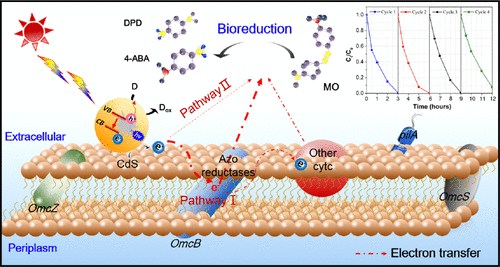当前位置:
X-MOL 学术
›
ACS Sustain. Chem. Eng.
›
论文详情
Our official English website, www.x-mol.net, welcomes your
feedback! (Note: you will need to create a separate account there.)
Fast Light-Driven Biodecolorization by a Geobacter sulfurreducens–CdS Biohybrid
ACS Sustainable Chemistry & Engineering ( IF 7.1 ) Pub Date : 2019-08-29 , DOI: 10.1021/acssuschemeng.9b02870 Shaofu Huang 1 , Jiahuan Tang 1 , Xing Liu 1 , Guowen Dong 2 , Shungui Zhou 1
ACS Sustainable Chemistry & Engineering ( IF 7.1 ) Pub Date : 2019-08-29 , DOI: 10.1021/acssuschemeng.9b02870 Shaofu Huang 1 , Jiahuan Tang 1 , Xing Liu 1 , Guowen Dong 2 , Shungui Zhou 1
Affiliation

|
Conventional biodecolorization of azo dyes is often limited by the lack of sustainable and bioavailable electron donors in aqueous environments. This limitation may be overcome by light-excited photoelectrons that drive the microbial reduction of azo dyes. Here, we innovatively developed a surface-precipitated Geobacter sulfurreducens–CdS biohybrid for the bioreduction of methyl orange (MO), a typical azo dye, driven by light. This biohybrid system exhibited the maximum kinetic constant at 1.441 h–1, which is, to the best of our knowledge, the highest value reported thus far for MO biodecolorization. The intermittent illumination results indicated that G. sulfurreducens could directly use extracellular photoelectrons (rather than electrons from organics oxidization by strains) in order to perform decolorization on the bacterial cell surface. This can be attributed to the direct electron transfer from CdS nanoparticles to G. sulfurreducens. In addition, OmcB was identified as a key outer-membrane protein that may act as a capacitor to modulate electron transfer from CdS to MO. This biohybrid catalytic approach may serve as a new strategy for azo dye degradation in oligotrophic surface waters and can deepen our knowledge on interactions between light, semiconductors and micro-organisms.
中文翻译:

降低土壤细菌中的硫还原菌–CdS生物杂化的快速光驱动生物脱色
偶氮染料的常规生物脱色通常受到水性环境中缺乏可持续的和可生物利用的电子供体的限制。该限制可以通过驱动偶氮染料的微生物还原的光激发光电子来克服。在这里,我们创新地开发了一种表面沉淀的还原性地球细菌减少硫菌-CdS生物杂化物,用于光驱使典型的偶氮染料甲基橙(MO)进行生物还原。这种生物混合系统在1.441 h –1处显示出最大的动力学常数,据我们所知,这是迄今为止MO生物脱色的最高值。间歇照明结果表明,G。硫还原可以直接使用细胞外光电子(而不是来自有机物被菌株氧化的电子)来对细菌细胞表面进行脱色。这可以归因于从CdS纳米粒子到还原硫短杆菌的直接电子转移。此外,OmcB被认为是关键的外膜蛋白,可以充当调节从CdS到MO的电子转移的电容器。这种生物混合催化方法可以作为寡营养地表水中偶氮染料降解的新策略,并且可以加深我们对光,半导体和微生物之间相互作用的认识。
更新日期:2019-08-29
中文翻译:

降低土壤细菌中的硫还原菌–CdS生物杂化的快速光驱动生物脱色
偶氮染料的常规生物脱色通常受到水性环境中缺乏可持续的和可生物利用的电子供体的限制。该限制可以通过驱动偶氮染料的微生物还原的光激发光电子来克服。在这里,我们创新地开发了一种表面沉淀的还原性地球细菌减少硫菌-CdS生物杂化物,用于光驱使典型的偶氮染料甲基橙(MO)进行生物还原。这种生物混合系统在1.441 h –1处显示出最大的动力学常数,据我们所知,这是迄今为止MO生物脱色的最高值。间歇照明结果表明,G。硫还原可以直接使用细胞外光电子(而不是来自有机物被菌株氧化的电子)来对细菌细胞表面进行脱色。这可以归因于从CdS纳米粒子到还原硫短杆菌的直接电子转移。此外,OmcB被认为是关键的外膜蛋白,可以充当调节从CdS到MO的电子转移的电容器。这种生物混合催化方法可以作为寡营养地表水中偶氮染料降解的新策略,并且可以加深我们对光,半导体和微生物之间相互作用的认识。

































 京公网安备 11010802027423号
京公网安备 11010802027423号